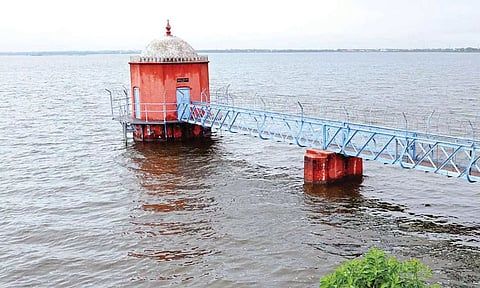

CHENNAI: Even as battered roads and incomplete storm water drains (SWDs) were discussed in the backdrop of sudden rains, the silver lining is not just the relief from the heat and humidity, and the dip in maximum temperature.
The 2-day showers have increased the storage capacity of Chembarambakkam reservoir by 7% and groundwater table by almost a foot. Additionally, the rains had also boosted the inflow from the Krishna river into the Poondi reservoir.
Copious rains across north TN had also benefitted the eastern ghats stretch, Yelagiri, Managalam Reserve area, Jawathu hills and Pachamalai reserve. “Water holes and streams are flowing to its full capacity. June rains are a much-needed boost for the wildlife,” opined a forest ranger in Vellore.
Meanwhile, experts and water managers urge the city residents to keep rainwater harvesting structures repaired and ready ahead of the monsoon season.
Water quantity in Chembarambakkam reservoir has increased from 19.1 feet to 19.7 feet of water. It has reached almost 70% of its maximum capacity of 22 feet. The reservoir receives 1,650 cusecs that includes inflow from the Poondi reservoir of 225 cusecs, as per data from Water Resources Department (WRD)
“At least 179 cusecs have been discharged for Metro Water board for irrigation, and also to balance the evaporation loss. There’s room for more in the reservoir. Any additional spell of rains will be a blessing and should be welcomed, especially considering that the southwest monsoon in 2022 failed to fill the catchment,” said a WRD official.
Similarly, Puzhal lake received 500 cusecs in the catchment area, increasing the water level by 0.3 TMC as against the capacity of 2.2 TMC. The reservoir also receives 300 cusecs from the Krishna river.
The inflow from Andhra Pradesh, which began in May, is expected to increase further if the water level there surges. “Though there is no time limit for the discharge from Krishna river, the inflow could be stopped immediately even with short notice,” WRD sources said.
Though the city and suburbs recorded 9 cm and 16 cm rainfall respectively in 24 hours on June 19, experts stated that a heavy downpour would have led to more run-off than help recharge the groundwater table level. “When there is a drizzle, it helps in recharging the groundwater level gradually. However, during the monsoon season, the situation is different and the stagnated water is drained out,” pointed out a senior WRD official.
Climate change plays a vital role, and so, the rainfall pattern might be affected during the monsoon season. “So, every house should have rainwater harvesting. It helps boost the groundwater level, and the entire neighbourhood too,” the official added.
Meanwhile, under the influence of the cyclonic circulation over southwest Bay of Bengal, several areas of north and south Tamil Nadu including Chennai, Tiruvallur, Chengalpattu, Kancheepuram, and Cuddalore are likely to receive light to moderate rain along with thunderstorm activity for the next 3 days, the Regional Meteorological Centre (RMC), Chennai stated.
The rest of the State is expected to receive mild showers.
The weather centre has also warned the fishermen not to venture into the sea till June 24, as squally wind speed reaching 55 kmph gusting to 65 kmph is likely to prevail over Gulf of Mannar, South Tamil Nadu coast, and adjoining Comorin area.